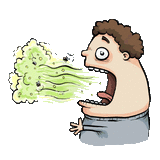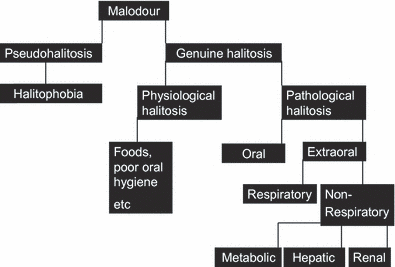
About 20% of the general population are reported to suffer from foul-smelling breath to some degree. 5‑72% of people feeling that they have bad breath, have no genuine halitosis. 90% of those who is diagnosed with halitosis have it because of their oral bacteria below the gum-line and on the back of the tongue. The remaining 10% is accounted for by many conditions, including disorders in the nasal cavity, tonsil stones, sinuses, throat, lungs, esophagus, stomach, pancreatic insufficiency, food sensitivities or metabolic disorders like TMAU.

Volatile sulphur compounds (VSCs) such as Hydrogen sulphide, Methyl mercaptan Dimethyl sulphide;
Volatile organic compounds such as Polyamines and Phenols including Cadaverine, Putrescine and Trimethylamine; Indole, Methyl-indole (Skatole), and Pyridiene; Alcohols - Ethanol, Propanol, Short-chain fatty acids including Acetic acid, Butyric acid, Propionic acid, Valeric acid; and various hydrocarbons - coming from swollen gums, inflamed sinuses, gums, gingival cells, back part of the tongue, food debris trapped between teeth and from the lung.
There are several causes of bad breath, but the most common is known as bacterial putrefaction. A variety of bacterial species eat up a variety of nutrients from food, saliva and dying cells, then produce several waste products known as volatile sulfur compounds (VSC), diamines and short chain fatty acids. All of these are quite pungent in smell and can easily emanate from the mouth into a nearby nose. The increased diversity of microbial species found in halitosis samples suggests that halitosis may be the result of complex interactions between several bacterial species. Main bacteria associated with halitosis include:
Bacteriodes intermedius (potent producer of hydrogen sulfide - see Sulfur odor)
Bacteroides loescheii (potent producer of hydrogen sulfide - see Sulfur odor)
Centipeda periodontii
Eikenella corrodens
Enterobacteriaceae
Fusobacterium nucleatum nucleatum
Fusobacterium nucleatum polymorphum
Fusobacterium nucleatum vincentii (volatile sulfur compounds)
Fusobacterium periodonticum
Porphyromonas endodontalis (potent producer of hydrogen sulfide - see Sulfur odor)
Porphyromonas gingivalis (potent producer of Methanethiol & Hydrogen sulfide - see Sulfur odor)
Prevotella (Bacteroides) melaninogenica
Prevotella intermedia
Solobacterium moorei (converts cysteine into hydrogen sulfide)
Tannerella forsythensis (Bacteroides forsythus)
Treponema denticola (potent producer of hydrogen sulfide - see Sulfur odor)
Most of these species are able to survive one week despite proper oral hygiene. Changing toothpaste brands, however, might help to reduce numbers of these microbes in less than a week.
A probiotic bacterium Streptococcus salivarius might be a helpful supplement to stop bad breath.
